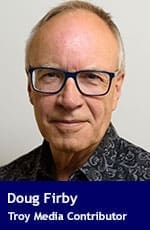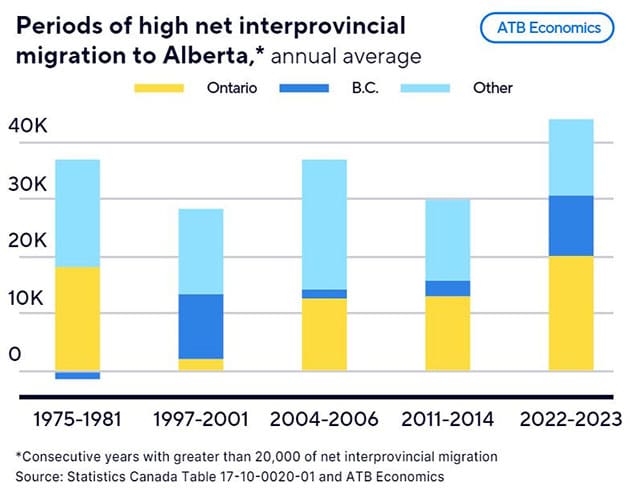What are the implications of Alberta’s population growth on housing affordability, jobs, and quality of life?
 Two recent reports underscore how rapidly and dramatically Alberta’s population is growing. This growth will have economists and many businesses cheering, but it is cause for concern among those of us who don’t believe in the cult of neverending growth.
Two recent reports underscore how rapidly and dramatically Alberta’s population is growing. This growth will have economists and many businesses cheering, but it is cause for concern among those of us who don’t believe in the cult of neverending growth.
Calgary, it turns out, is the fastest-growing city in Canada from interprovincial migration. From Jul. 1, 2022, to Jun. 30, 2023, the city attracted 26,662 residents from other parts of Canada, according to Statistics Canada. Almost 96,000 people came to the city from all destinations, bringing the population to 1.7 million. Edmonton wasn’t far behind, with 16,082 new residents from interprovincial migration and a total of 63,000 people from all destinations, bringing its population to 1.6 million.
ATB, the provincial financial institution, forecasts net interprovincial migration – the number of people who come here minus the number who leave – at 45,000 in 2024, easing to 24,000 in 2025 and 23,000 in 2026. ATB’s Chief Economist Mark Parsons notes that for the first half of census 2024, Alberta has already welcomed 27,000 new residents from the rest of Canada. More shocking is the 202,000 people in total who came here from all destinations in 2023. That’s a 4.4 percent growth rate, higher than any other province.
Remarkably, Alberta has been creating jobs about as quickly as people are coming, so the unemployment rate of 6.4 percent has stayed steady. Alberta is adding jobs faster than the national average over the last two years, including in British Columbia and Ontario.
Previous booms in population growth have been fueled by heightened activity in the oil patch. And it is true that things are looking relatively robust in Fort McMurry these days. But Parsons argues it’s not the oil patch driving this influx. While oil and gas investment has improved steadily since COVID, ATB notes, it remains about half of 2014 levels.
People are moving here not just for jobs but also for affordable housing. ATB cites two recent studies to support this claim: The Re/Max 2024 Canadian Housing Market Outlook found that 21 percent of Canadians (read Torontonians and Vancouverites) are “exploring alternative home ownership, or opting for inter-provincial/city moves.” And a 2023 survey by Royal LePage found that roughly one-third of households purchased a home in a more affordable region than they had planned.

These numbers made me ponder how much this province has changed in the past two decades-plus since our family moved here. In 2001, there were 3.1 million hardy (well, most of them) Albertans; this year there are 4.8 million – an increase of more than 50 percent.
There are, yes, reasons we should welcome this growth. Having more people in this province means we carry more clout within Confederation. We are not one of those little prairie provinces that Ottawa finds so easy to ignore. Our children will have more career opportunities here. The population is more diversified, with more visible minorities from around the world – bringing with them beautiful cultural traditions and adventurous cuisine.
But growth also has some significant downsides. One dramatic example is the pressure that is building in our beautiful parks and wild places. Banff and Lake Louise in summer, for example, are so choked with tourists that many Albertans simply never go there. Kananaskis Country, the stunning wildlife preserve in the eastern Rockies and foothills created by the late Premier Peter Lougheed, has seen such an increase in visitors that the province (controversially) imposed a stiff daily user fee that is at odds with Lougheed’s original vision for the area.
Camping spots are booked so quickly (and too often by people who reserve them and don’t show up) that it has become frustrating to find a natural area available for camping when you want to go.
Meanwhile, the once-sacred grassy fields at the heart of Alberta’s cowboy image have become so commercially valuable that buying the land is nearly impossible – unless it’s for massive housing, commercial, or industrial developments. Our two biggest cities are expanding so rapidly that it’s only a matter of time before they engulf towns like Leduc, Cochrane, and Okotoks, which once felt safely out of reach. Commuting by car has become a nightmare. In other words, the unique qualities that make this place special are under more pressure than ever before.
And, in an ironic twist, the demand for housing is so intense that prices in Alberta will soon match or even exceed those in the rest of Canada. In March 2022, Alberta’s benchmark prices were $466,200, a full $369,100 less than the national average. By April of this year, the gap had shrunk to $213,300 and is continuing to narrow quickly. Rent prices are also skyrocketing.
So, there is a major quality-of-life concern with no obvious remedy. If only we could put a wall around those cities! (Okotoks and Canmore both have tried that strategy, by the way, but eventually had to concede that outward growth could, at best, be managed but not stopped.)
Growth is often overstated as a virtue. Proponents of growth emphasize the good that will come with it while turning a blind eye to the bad. Growth is the crack cocaine of social progress; in the short term, it delivers a real high, but the long-term consequences can do more harm than good.
The influx of “new Albertans” is, or should be, also a concern to the politicians who have historically relied on the traditional rural vote to hang onto power. As Alberta’s cities have grown, the influx of citizens has tilted voters further left. It is notable, in particular, that “right-wing” Calgary has a left-wing, or “progressive” if you prefer that term, council.
Calgary’s progressive former mayor, Naheed Nenshi, is so popular that nearly half of the NDP’s 85,144 members are from this city. If Nenshi succeeds in winning the NDP leadership and makes good on a promise to court voters from smaller cities, towns, and rural areas, the long-predicted tectonic shift in the political map may come to fruition. At the very least, voters will have two viable choices when it’s time to go to the polls.
Change. You can’t stop it. In my heart, I feel a measure of melancholy for the charming and gentler Alberta I found when I got here 22 years ago. That image of the province is fading fast. Let us hope the people and leaders of Alberta have the vision to lead us to a modern Alberta that we’ll love in its own way.
Doug Firby is an award-winning editorial writer with over four decades of experience working for newspapers, magazines and online publications in Ontario and western Canada. Previously, he served as Editorial Page Editor at the Calgary Herald.
For interview requests, click here.
The opinions expressed by our columnists and contributors are theirs alone and do not inherently or expressly reflect the views of our publication.
© Troy Media
Troy Media is an editorial content provider to media outlets and its own hosted community news outlets across Canada.

